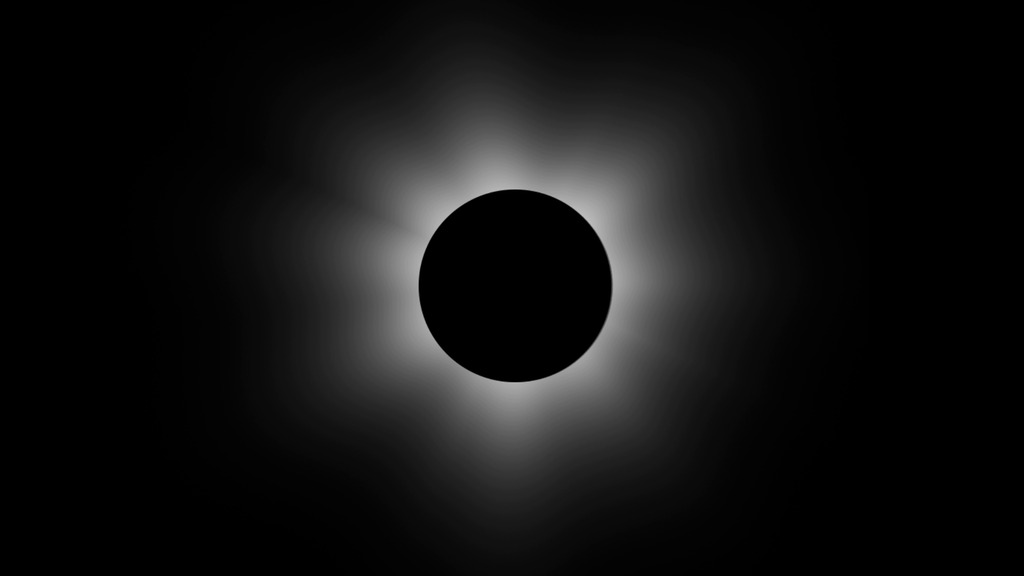The Total Solar Eclipse of 20 March 2015
This narrated video shows visualizations of the March 20, 2015 solar eclipse from several vantage points in space, as well as an actual photo of a previous eclipse in 2012 taken by LRO from lunar orbit. Transcript.
On March 20, 2015, the shadow of the Moon crosses the surface of the Earth, creating a total solar eclipse. The eclipse occurs on the date of the March equinox, the start of spring in the northern hemisphere.
From well beyond the Moon's far side, the shadow appears circular. The central black dot is the umbra, where the Sun is completely covered by the Moon. The fainter, much larger shadow is the penumbra, where the Sun is only partially obscured.
Viewed from overhead, the umbra is quite elongated. It hits the Earth at a glancing angle, beginning at a point south of Greenland and departing very near the north pole. The Faroe Islands and the Svalbard archipeligo are in the path of the umbra, but the umbra just misses Iceland, and it crosses no other populated land.
The penumbra covers all of Europe and extends to north Africa and across most of Russia. Everyone in those places will see a partial eclipse.
Both astronauts and robotic probes have witnessed solar eclipses from space. For the annular eclipse in May of 2012, Lunar Reconnaissance Orbiter turned its narrow-angle camera away from the Moon and toward Earth, capturing four still images of the Moon's shadow as it traveled from Japan to the Aleutian Islands and the west coast of the United States.
Visualization of the March 20, 2015 total solar eclipse as it appears from beyond the far side of the Moon. From this vantage point, the shadow looks circular.
Visualization of the Moon's shadow as viewed from above the location on the Earth where maximum eclipse occurs. In this view, the elongation of the shadow is apparent.
Visualization of the Moon's orbit and the shadows of the Earth and Moon during the several months leading up to the March 20, 2015 total solar eclipse. The Earth, Moon, shadows, and orbit are all to scale. The Sun is several hundred image widths to the left.
A globe-like illustration of the umbra and penumbra extents.
Simulation of the May, 2012 annular solar eclipse as seen from the Moon. This eclipse was photographed from lunar orbit by LRO.

Image of the May, 2012 annular solar eclipse, taken by LRO's narrow angle camera at 00:33:42 UTC on May 21. This is NAC image E192199689L, scaled and rotated to match frame 642 of the above animation.

Within the penumbra, the eclipse is partial (left), but within the umbra, the Moon completely covers the Sun (right).
For More Information
Credits
Please give credit for this item to:
NASA's Scientific Visualization Studio
-
Visualizer
-
Ernie Wright
(USRA)
-
Ernie Wright
(USRA)
-
Producer
- David Ladd (USRA)
-
Scientists
- John Keller (NASA/GSFC)
-
Noah Petro
(NASA/GSFC)
Missions
This page is related to the following missions:Series
This page can be found in the following series:Tapes
The media on this page originally appeared on the following tapes:-
Shadow of the Moon
(ID: 2015026)
Friday, March 13, 2015 at 4:00AM
Produced by - Marit Jentoft-Nilsen (RSIS)
Datasets used
-
BMNG (Blue Marble: Next Generation) [Terra and Aqua: MODIS]
ID: 508Credit: The Blue Marble data is courtesy of Reto Stockli (NASA/GSFC).
This dataset can be found at: http://earthobservatory.nasa.gov/Newsroom/BlueMarble/
See all pages that use this dataset -
DEM (Digital Elevation Map) [LRO: LOLA]
ID: 653 -
DE421 (JPL DE421)
ID: 752Planetary ephemerides
This dataset can be found at: http://ssd.jpl.nasa.gov/?ephemerides#planets
See all pages that use this dataset -
WAC 643nm High Sun Global Mosaic [LRO: LROC]
ID: 803
Note: While we identify the data sets used on this page, we do not store any further details, nor the data sets themselves on our site.
Release date
This page was originally published on Friday, March 13, 2015.
This page was last updated on Wednesday, May 3, 2023 at 1:49 PM EDT.
